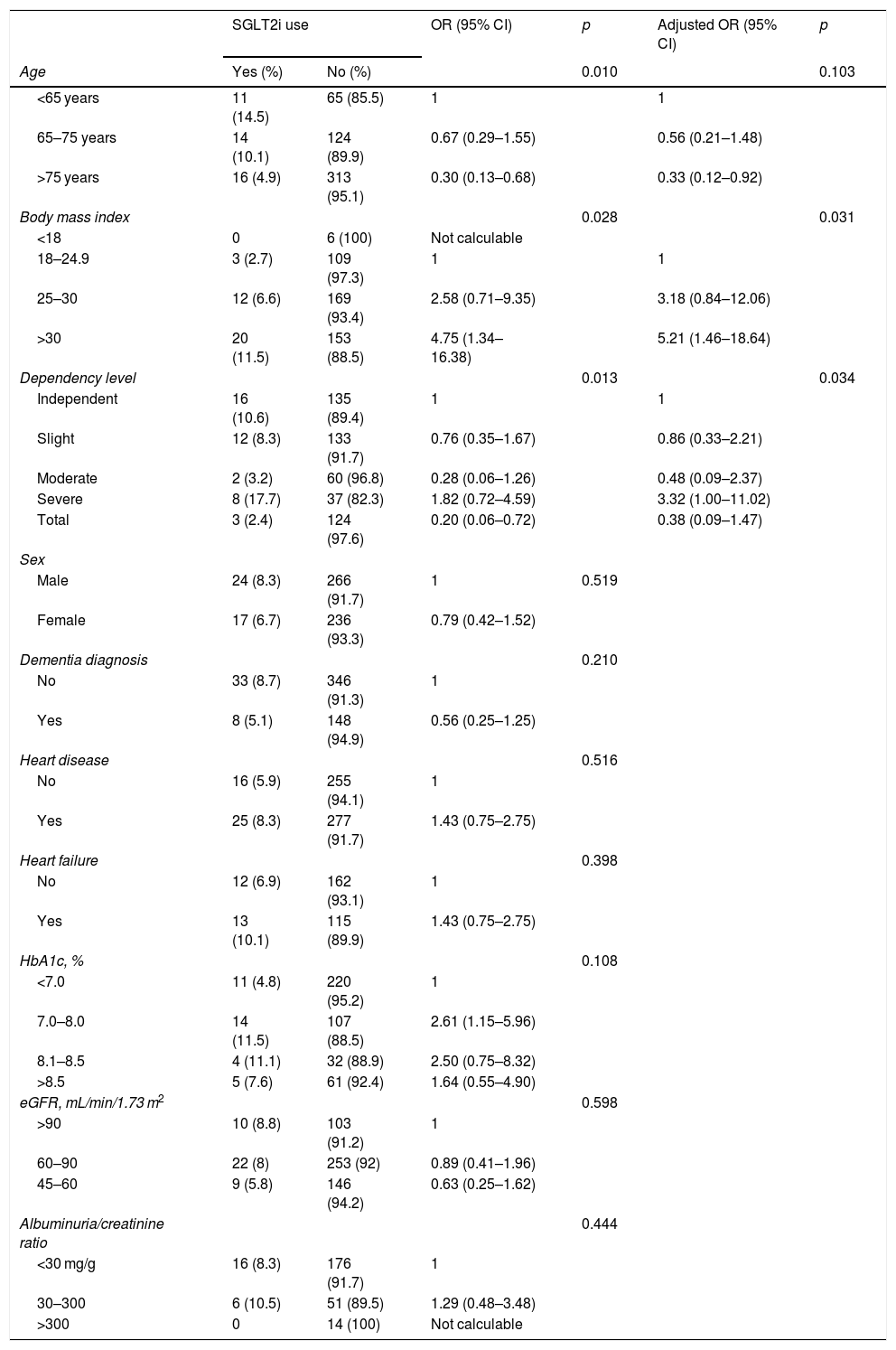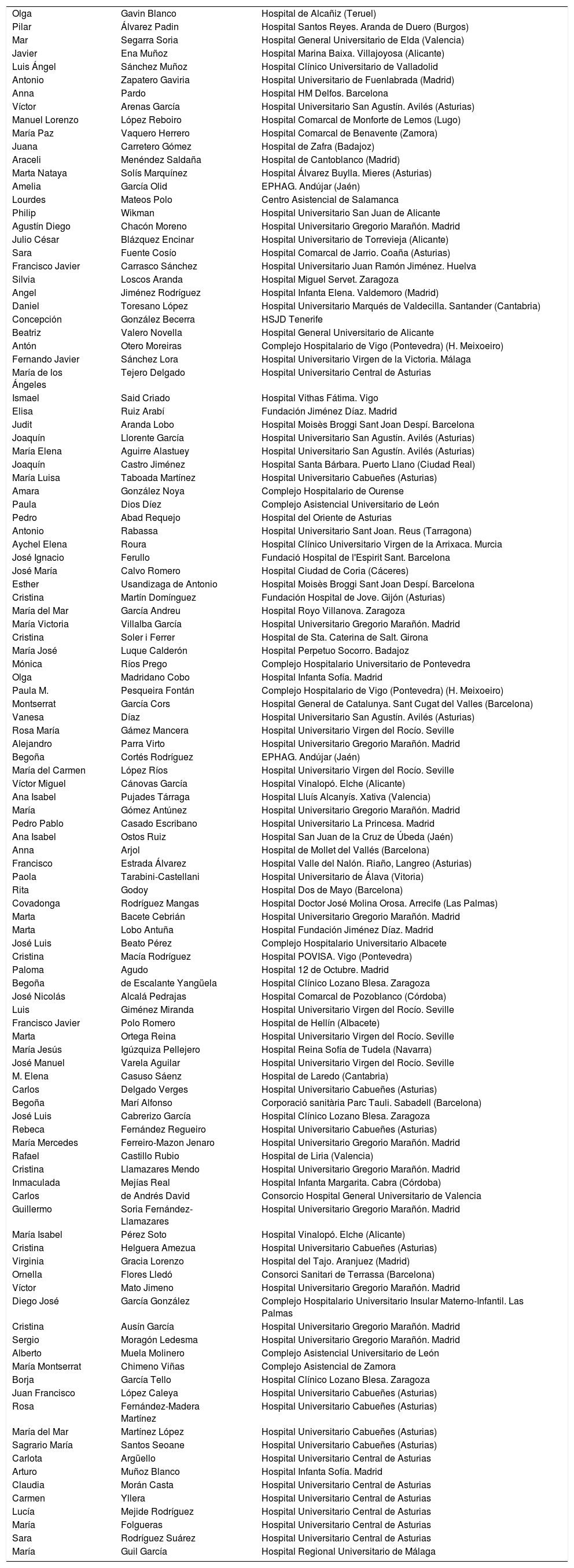To evaluate the use of therapy with cardiovascular benefit in patients with type 2 diabetes mellitus admitted to internal medicine departments.
MethodsOne day, cross-sectional study of patients with type 2 diabetes mellitus hospitalised in internal medicine departments. We recorded demographic and anthropometric variables, laboratory data and use of antihyperglycaemic drugs. The endpoint was the proportion and determinants of the use of sodium-glucose cotransporter-2 inhibitors (SGLT2i) and glucagon-like peptide-1 receptor agonists (GLP1-RA).
ResultsWe included 928 patients belonging to 74 hospitals, with a mean age of 78.9 years (SD, 10.86 years), 50% of whom were men. A total of 557 (60%) patients had ischaemic heart disease, 189 (20.4%) had cerebrovascular disease, 293 (31.6%) had heart failure, 274 (29.5%) had chronic kidney disease, and 129 (13.9%) had peripheral arterial disease. Prior to their hospital admission, the patients were taking sulfonylureas (5.7%), biguanides (49.1%), alpha-glucosidase inhibitors (0.2%), pioglitazone (0%), dipeptidyl peptidase 4 inhibitors (39%), SGLT2i (5.8%), GLP1-RA (2.6%) and basal insulin analogues (24%). An age over 75 years was the main determinant for not taking SGLT2i (adjusted OR, 0.28; 95% CI 0.10–0.74; p = .039) or GLP1-RA (adjusted OR, 0.09; 95% CI 0.02–0.46; p = .006).
DiscussionA large proportion of elderly patients with type 2 diabetes mellitus at very high cardiovascular risk are not treated with antihyperglycemic drugs with proven cardiovascular benefit. The most commonly used drugs were metformin and DPP4i. There is room for improvement in the treatment of this very high-risk population.
Evaluar el uso de la terapia con beneficio cardiovascular en pacientes con DM tipo 2 previo al ingreso en servicios de medicina interna.
MétodosEstudio transversal en un día de los pacientes con DM tipo 2 hospitalizados en servicios de medicina interna. Se recogieron variables demográficas y antropométricas, datos de laboratorio y utilización de fármacos antihiperglucemiantes. La variable desenlace fue la proporción y los determinantes de uso de inhibidores del cotransportador sodio-glucosa 2 (iSGLT2) y de agonistas del receptor del péptido similar al glucagón tipo 1 (AR-GLP1).
ResultadosSe incluyeron 928 pacientes pertenecientes a 74 hospitales. La edad media fue 78,9 años (DE: 10,86), un 50% varones. Un total de 557 (60%) presentaba cardiopatía isquémica, 189 (20,4%) enfermedad cerebrovascular, 293 (31,6%) insuficiencia cardiaca, 274 (29,5%) enfermedad renal crónica y 129 (13,9%) enfermedad arterial periférica. Los antihiperglucemiantes utilizados previo al ingreso fueron: sulfonilureas (5.7%), biguanidas (49.1%), inhibidores de la alfa-glucosidasa (0,2%), pioglitazona (0%), iDPP4 (39%), iSGLT2 (5,8%), AR-GLP1 (2,6%) y análogos de insulina basal (24%). La edad mayor de 75 años fue el factor determinante principal para no utilizar iSGLT2 (OR ajustada 0,28; intervalo de confianza al 95%: 0,10–0,74; p = 0,039) o AR-GLP1 (OR ajustada 0,09; intervalo de confianza al 95%: 0,02–0,46; p = 0,006).
DiscusiónUna gran proporción de pacientes ancianos con DM tipo 2 de muy alto riesgo cardiovascular no recibe terapia antihiperglucemiante con fármacos de probado beneficio cardiovascular. El tratamiento más frecuentemente utilizado fue metformina e iDPP4. Existe un margen de mejora en el tratamiento en esta población de muy alto riesgo.
Article
Diríjase desde aquí a la web de la >>>FESEMI<<< e inicie sesión mediante el formulario que se encuentra en la barra superior, pulsando sobre el candado.

Una vez autentificado, en la misma web de FESEMI, en el menú superior, elija la opción deseada.

>>>FESEMI<<<











